De Montfort University E-Commerce System: SWOT & ICDT Analysis
VerifiedAdded on 2021/04/21
|6
|1627
|18
Report
AI Summary
This report provides a comprehensive analysis of De Montfort University's e-commerce system. It begins with a SWOT analysis, evaluating the university's strengths (reputation, quality of education), weaknesses (high fees), opportunities (international student recruitment, distance learning), and threats (competitive universities). The report then applies Angehrn's ICDT model to define objectives, focusing on increasing profitability through revenue growth and community building. It further explores the university's communication strategies, addressing cultural and trust issues through various tools, including email and social media. Recommendations are provided to improve the e-commerce system, such as adjusting fees and enhancing communication with prospective students. The report references key academic sources to support its findings.
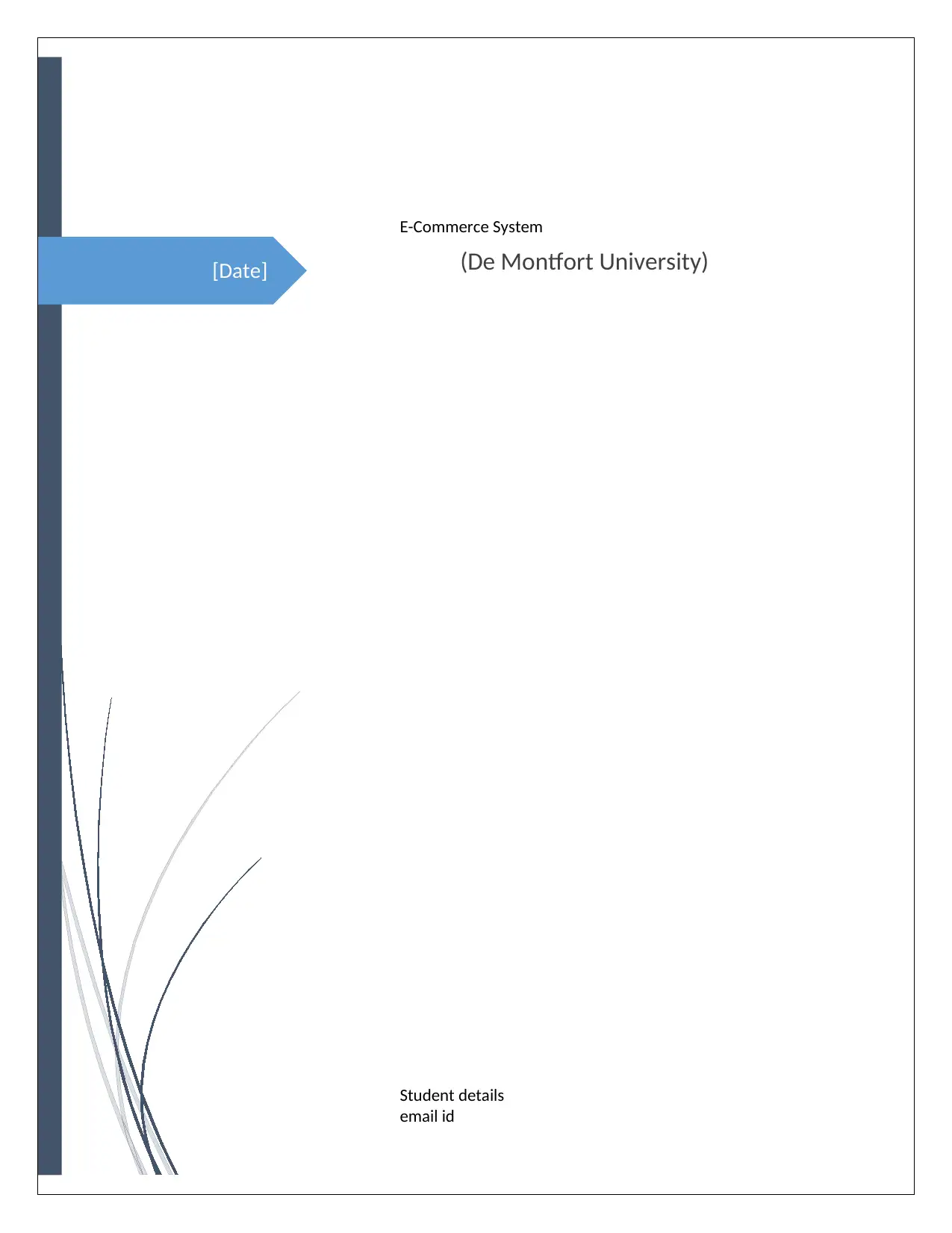
[Date]
E-Commerce System
(De Montfort University)
Student details
email id
E-Commerce System
(De Montfort University)
Student details
email id
Paraphrase This Document
Need a fresh take? Get an instant paraphrase of this document with our AI Paraphraser
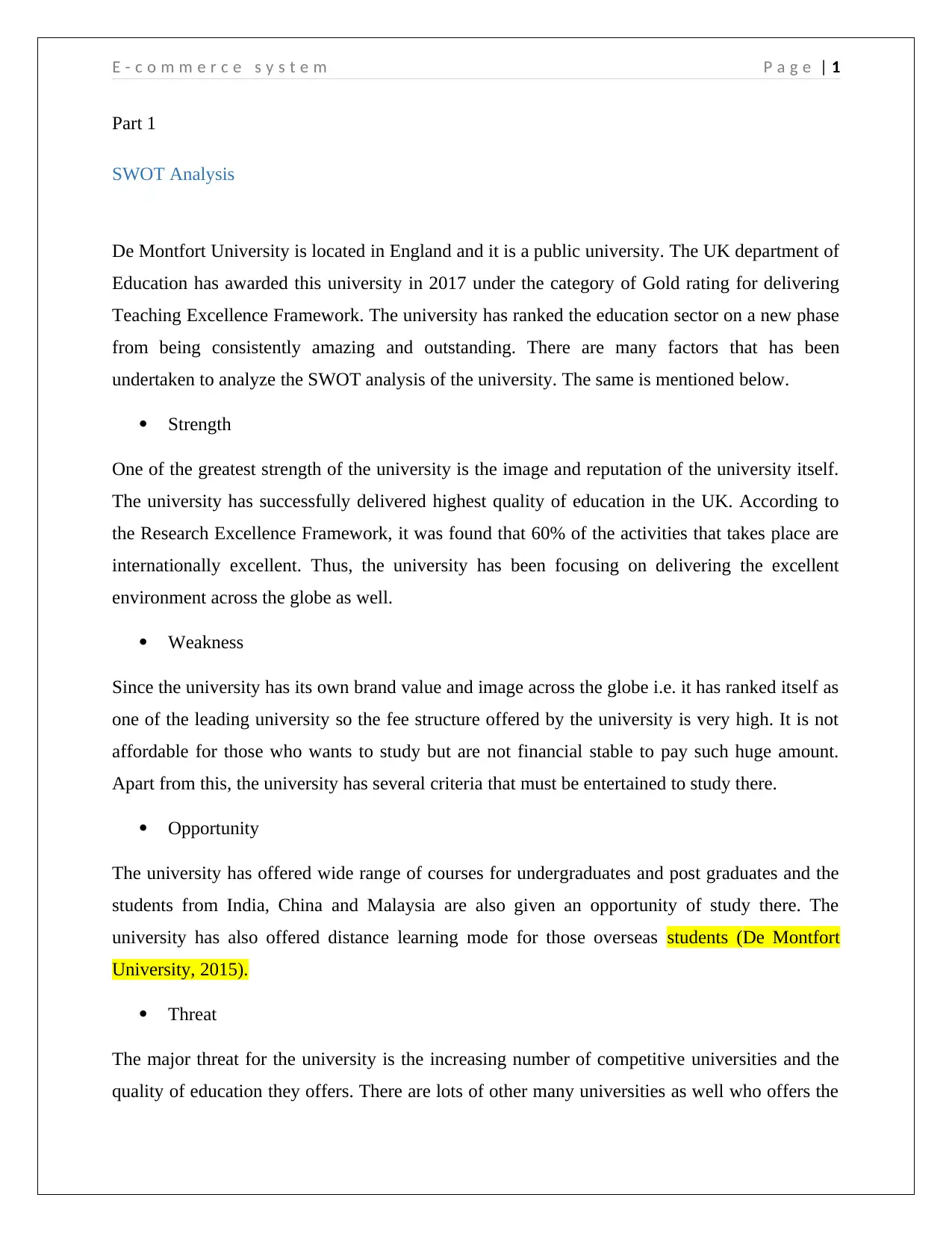
E - c o m m e r c e s y s t e m P a g e | 1
Part 1
SWOT Analysis
De Montfort University is located in England and it is a public university. The UK department of
Education has awarded this university in 2017 under the category of Gold rating for delivering
Teaching Excellence Framework. The university has ranked the education sector on a new phase
from being consistently amazing and outstanding. There are many factors that has been
undertaken to analyze the SWOT analysis of the university. The same is mentioned below.
Strength
One of the greatest strength of the university is the image and reputation of the university itself.
The university has successfully delivered highest quality of education in the UK. According to
the Research Excellence Framework, it was found that 60% of the activities that takes place are
internationally excellent. Thus, the university has been focusing on delivering the excellent
environment across the globe as well.
Weakness
Since the university has its own brand value and image across the globe i.e. it has ranked itself as
one of the leading university so the fee structure offered by the university is very high. It is not
affordable for those who wants to study but are not financial stable to pay such huge amount.
Apart from this, the university has several criteria that must be entertained to study there.
Opportunity
The university has offered wide range of courses for undergraduates and post graduates and the
students from India, China and Malaysia are also given an opportunity of study there. The
university has also offered distance learning mode for those overseas students (De Montfort
University, 2015).
Threat
The major threat for the university is the increasing number of competitive universities and the
quality of education they offers. There are lots of other many universities as well who offers the
Part 1
SWOT Analysis
De Montfort University is located in England and it is a public university. The UK department of
Education has awarded this university in 2017 under the category of Gold rating for delivering
Teaching Excellence Framework. The university has ranked the education sector on a new phase
from being consistently amazing and outstanding. There are many factors that has been
undertaken to analyze the SWOT analysis of the university. The same is mentioned below.
Strength
One of the greatest strength of the university is the image and reputation of the university itself.
The university has successfully delivered highest quality of education in the UK. According to
the Research Excellence Framework, it was found that 60% of the activities that takes place are
internationally excellent. Thus, the university has been focusing on delivering the excellent
environment across the globe as well.
Weakness
Since the university has its own brand value and image across the globe i.e. it has ranked itself as
one of the leading university so the fee structure offered by the university is very high. It is not
affordable for those who wants to study but are not financial stable to pay such huge amount.
Apart from this, the university has several criteria that must be entertained to study there.
Opportunity
The university has offered wide range of courses for undergraduates and post graduates and the
students from India, China and Malaysia are also given an opportunity of study there. The
university has also offered distance learning mode for those overseas students (De Montfort
University, 2015).
Threat
The major threat for the university is the increasing number of competitive universities and the
quality of education they offers. There are lots of other many universities as well who offers the
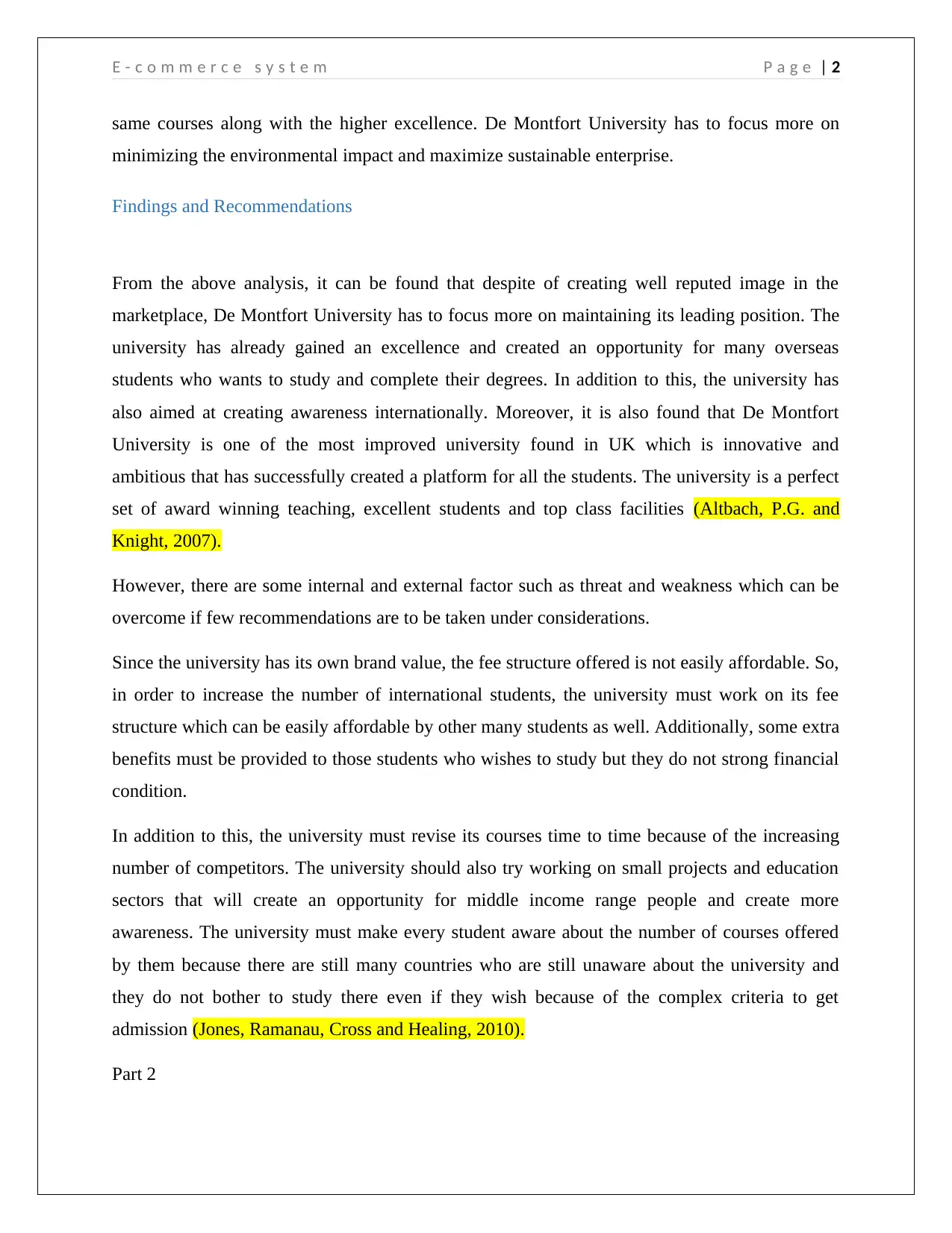
E - c o m m e r c e s y s t e m P a g e | 2
same courses along with the higher excellence. De Montfort University has to focus more on
minimizing the environmental impact and maximize sustainable enterprise.
Findings and Recommendations
From the above analysis, it can be found that despite of creating well reputed image in the
marketplace, De Montfort University has to focus more on maintaining its leading position. The
university has already gained an excellence and created an opportunity for many overseas
students who wants to study and complete their degrees. In addition to this, the university has
also aimed at creating awareness internationally. Moreover, it is also found that De Montfort
University is one of the most improved university found in UK which is innovative and
ambitious that has successfully created a platform for all the students. The university is a perfect
set of award winning teaching, excellent students and top class facilities (Altbach, P.G. and
Knight, 2007).
However, there are some internal and external factor such as threat and weakness which can be
overcome if few recommendations are to be taken under considerations.
Since the university has its own brand value, the fee structure offered is not easily affordable. So,
in order to increase the number of international students, the university must work on its fee
structure which can be easily affordable by other many students as well. Additionally, some extra
benefits must be provided to those students who wishes to study but they do not strong financial
condition.
In addition to this, the university must revise its courses time to time because of the increasing
number of competitors. The university should also try working on small projects and education
sectors that will create an opportunity for middle income range people and create more
awareness. The university must make every student aware about the number of courses offered
by them because there are still many countries who are still unaware about the university and
they do not bother to study there even if they wish because of the complex criteria to get
admission (Jones, Ramanau, Cross and Healing, 2010).
Part 2
same courses along with the higher excellence. De Montfort University has to focus more on
minimizing the environmental impact and maximize sustainable enterprise.
Findings and Recommendations
From the above analysis, it can be found that despite of creating well reputed image in the
marketplace, De Montfort University has to focus more on maintaining its leading position. The
university has already gained an excellence and created an opportunity for many overseas
students who wants to study and complete their degrees. In addition to this, the university has
also aimed at creating awareness internationally. Moreover, it is also found that De Montfort
University is one of the most improved university found in UK which is innovative and
ambitious that has successfully created a platform for all the students. The university is a perfect
set of award winning teaching, excellent students and top class facilities (Altbach, P.G. and
Knight, 2007).
However, there are some internal and external factor such as threat and weakness which can be
overcome if few recommendations are to be taken under considerations.
Since the university has its own brand value, the fee structure offered is not easily affordable. So,
in order to increase the number of international students, the university must work on its fee
structure which can be easily affordable by other many students as well. Additionally, some extra
benefits must be provided to those students who wishes to study but they do not strong financial
condition.
In addition to this, the university must revise its courses time to time because of the increasing
number of competitors. The university should also try working on small projects and education
sectors that will create an opportunity for middle income range people and create more
awareness. The university must make every student aware about the number of courses offered
by them because there are still many countries who are still unaware about the university and
they do not bother to study there even if they wish because of the complex criteria to get
admission (Jones, Ramanau, Cross and Healing, 2010).
Part 2
⊘ This is a preview!⊘
Do you want full access?
Subscribe today to unlock all pages.

Trusted by 1+ million students worldwide
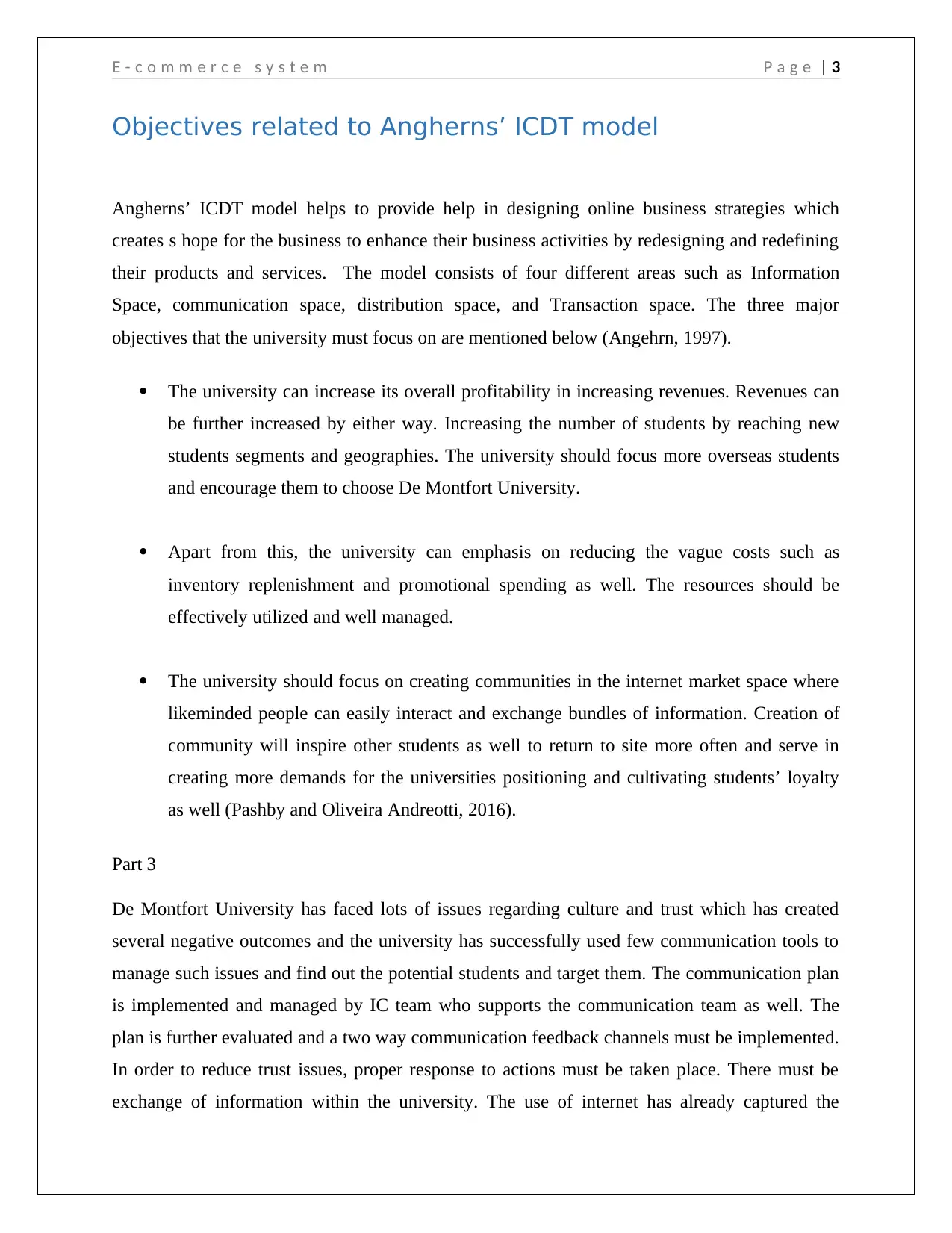
E - c o m m e r c e s y s t e m P a g e | 3
Objectives related to Angherns’ ICDT model
Angherns’ ICDT model helps to provide help in designing online business strategies which
creates s hope for the business to enhance their business activities by redesigning and redefining
their products and services. The model consists of four different areas such as Information
Space, communication space, distribution space, and Transaction space. The three major
objectives that the university must focus on are mentioned below (Angehrn, 1997).
The university can increase its overall profitability in increasing revenues. Revenues can
be further increased by either way. Increasing the number of students by reaching new
students segments and geographies. The university should focus more overseas students
and encourage them to choose De Montfort University.
Apart from this, the university can emphasis on reducing the vague costs such as
inventory replenishment and promotional spending as well. The resources should be
effectively utilized and well managed.
The university should focus on creating communities in the internet market space where
likeminded people can easily interact and exchange bundles of information. Creation of
community will inspire other students as well to return to site more often and serve in
creating more demands for the universities positioning and cultivating students’ loyalty
as well (Pashby and Oliveira Andreotti, 2016).
Part 3
De Montfort University has faced lots of issues regarding culture and trust which has created
several negative outcomes and the university has successfully used few communication tools to
manage such issues and find out the potential students and target them. The communication plan
is implemented and managed by IC team who supports the communication team as well. The
plan is further evaluated and a two way communication feedback channels must be implemented.
In order to reduce trust issues, proper response to actions must be taken place. There must be
exchange of information within the university. The use of internet has already captured the
Objectives related to Angherns’ ICDT model
Angherns’ ICDT model helps to provide help in designing online business strategies which
creates s hope for the business to enhance their business activities by redesigning and redefining
their products and services. The model consists of four different areas such as Information
Space, communication space, distribution space, and Transaction space. The three major
objectives that the university must focus on are mentioned below (Angehrn, 1997).
The university can increase its overall profitability in increasing revenues. Revenues can
be further increased by either way. Increasing the number of students by reaching new
students segments and geographies. The university should focus more overseas students
and encourage them to choose De Montfort University.
Apart from this, the university can emphasis on reducing the vague costs such as
inventory replenishment and promotional spending as well. The resources should be
effectively utilized and well managed.
The university should focus on creating communities in the internet market space where
likeminded people can easily interact and exchange bundles of information. Creation of
community will inspire other students as well to return to site more often and serve in
creating more demands for the universities positioning and cultivating students’ loyalty
as well (Pashby and Oliveira Andreotti, 2016).
Part 3
De Montfort University has faced lots of issues regarding culture and trust which has created
several negative outcomes and the university has successfully used few communication tools to
manage such issues and find out the potential students and target them. The communication plan
is implemented and managed by IC team who supports the communication team as well. The
plan is further evaluated and a two way communication feedback channels must be implemented.
In order to reduce trust issues, proper response to actions must be taken place. There must be
exchange of information within the university. The use of internet has already captured the
Paraphrase This Document
Need a fresh take? Get an instant paraphrase of this document with our AI Paraphraser
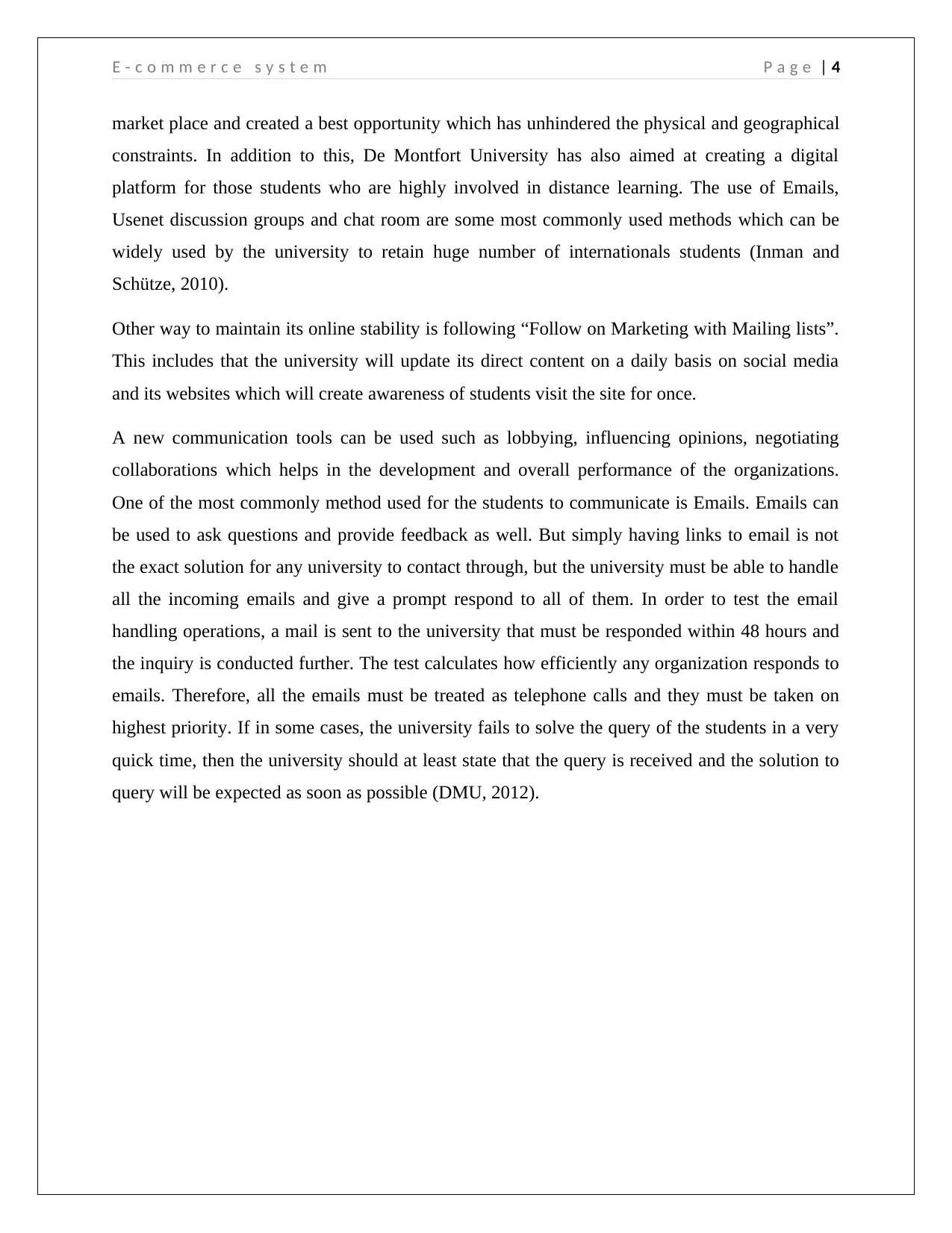
E - c o m m e r c e s y s t e m P a g e | 4
market place and created a best opportunity which has unhindered the physical and geographical
constraints. In addition to this, De Montfort University has also aimed at creating a digital
platform for those students who are highly involved in distance learning. The use of Emails,
Usenet discussion groups and chat room are some most commonly used methods which can be
widely used by the university to retain huge number of internationals students (Inman and
Schütze, 2010).
Other way to maintain its online stability is following “Follow on Marketing with Mailing lists”.
This includes that the university will update its direct content on a daily basis on social media
and its websites which will create awareness of students visit the site for once.
A new communication tools can be used such as lobbying, influencing opinions, negotiating
collaborations which helps in the development and overall performance of the organizations.
One of the most commonly method used for the students to communicate is Emails. Emails can
be used to ask questions and provide feedback as well. But simply having links to email is not
the exact solution for any university to contact through, but the university must be able to handle
all the incoming emails and give a prompt respond to all of them. In order to test the email
handling operations, a mail is sent to the university that must be responded within 48 hours and
the inquiry is conducted further. The test calculates how efficiently any organization responds to
emails. Therefore, all the emails must be treated as telephone calls and they must be taken on
highest priority. If in some cases, the university fails to solve the query of the students in a very
quick time, then the university should at least state that the query is received and the solution to
query will be expected as soon as possible (DMU, 2012).
market place and created a best opportunity which has unhindered the physical and geographical
constraints. In addition to this, De Montfort University has also aimed at creating a digital
platform for those students who are highly involved in distance learning. The use of Emails,
Usenet discussion groups and chat room are some most commonly used methods which can be
widely used by the university to retain huge number of internationals students (Inman and
Schütze, 2010).
Other way to maintain its online stability is following “Follow on Marketing with Mailing lists”.
This includes that the university will update its direct content on a daily basis on social media
and its websites which will create awareness of students visit the site for once.
A new communication tools can be used such as lobbying, influencing opinions, negotiating
collaborations which helps in the development and overall performance of the organizations.
One of the most commonly method used for the students to communicate is Emails. Emails can
be used to ask questions and provide feedback as well. But simply having links to email is not
the exact solution for any university to contact through, but the university must be able to handle
all the incoming emails and give a prompt respond to all of them. In order to test the email
handling operations, a mail is sent to the university that must be responded within 48 hours and
the inquiry is conducted further. The test calculates how efficiently any organization responds to
emails. Therefore, all the emails must be treated as telephone calls and they must be taken on
highest priority. If in some cases, the university fails to solve the query of the students in a very
quick time, then the university should at least state that the query is received and the solution to
query will be expected as soon as possible (DMU, 2012).
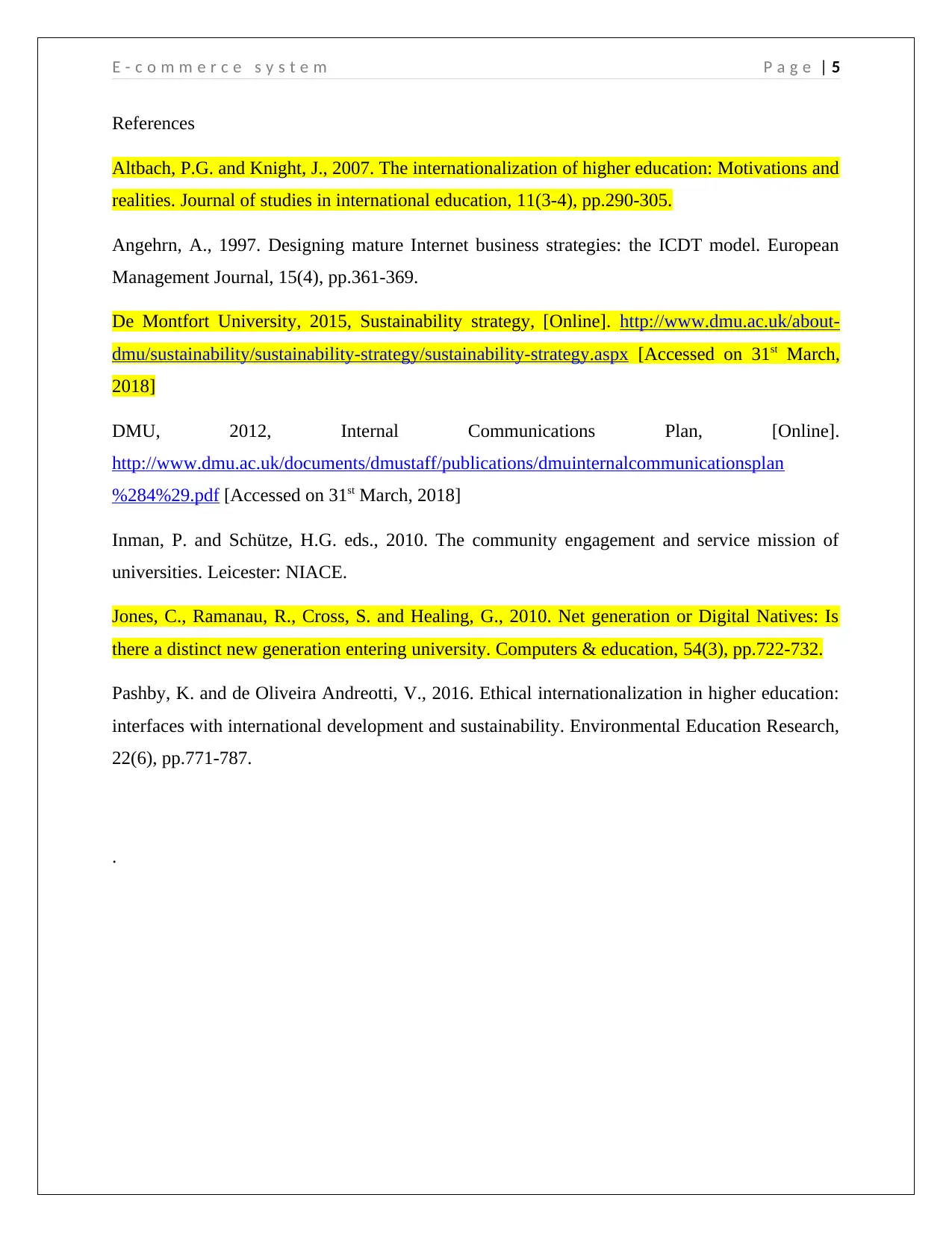
E - c o m m e r c e s y s t e m P a g e | 5
References
Altbach, P.G. and Knight, J., 2007. The internationalization of higher education: Motivations and
realities. Journal of studies in international education, 11(3-4), pp.290-305.
Angehrn, A., 1997. Designing mature Internet business strategies: the ICDT model. European
Management Journal, 15(4), pp.361-369.
De Montfort University, 2015, Sustainability strategy, [Online]. http://www.dmu.ac.uk/about-
dmu/sustainability/sustainability-strategy/sustainability-strategy.aspx [Accessed on 31st March,
2018]
DMU, 2012, Internal Communications Plan, [Online].
http://www.dmu.ac.uk/documents/dmustaff/publications/dmuinternalcommunicationsplan
%284%29.pdf [Accessed on 31st March, 2018]
Inman, P. and Schütze, H.G. eds., 2010. The community engagement and service mission of
universities. Leicester: NIACE.
Jones, C., Ramanau, R., Cross, S. and Healing, G., 2010. Net generation or Digital Natives: Is
there a distinct new generation entering university. Computers & education, 54(3), pp.722-732.
Pashby, K. and de Oliveira Andreotti, V., 2016. Ethical internationalization in higher education:
interfaces with international development and sustainability. Environmental Education Research,
22(6), pp.771-787.
.
References
Altbach, P.G. and Knight, J., 2007. The internationalization of higher education: Motivations and
realities. Journal of studies in international education, 11(3-4), pp.290-305.
Angehrn, A., 1997. Designing mature Internet business strategies: the ICDT model. European
Management Journal, 15(4), pp.361-369.
De Montfort University, 2015, Sustainability strategy, [Online]. http://www.dmu.ac.uk/about-
dmu/sustainability/sustainability-strategy/sustainability-strategy.aspx [Accessed on 31st March,
2018]
DMU, 2012, Internal Communications Plan, [Online].
http://www.dmu.ac.uk/documents/dmustaff/publications/dmuinternalcommunicationsplan
%284%29.pdf [Accessed on 31st March, 2018]
Inman, P. and Schütze, H.G. eds., 2010. The community engagement and service mission of
universities. Leicester: NIACE.
Jones, C., Ramanau, R., Cross, S. and Healing, G., 2010. Net generation or Digital Natives: Is
there a distinct new generation entering university. Computers & education, 54(3), pp.722-732.
Pashby, K. and de Oliveira Andreotti, V., 2016. Ethical internationalization in higher education:
interfaces with international development and sustainability. Environmental Education Research,
22(6), pp.771-787.
.
⊘ This is a preview!⊘
Do you want full access?
Subscribe today to unlock all pages.

Trusted by 1+ million students worldwide
1 out of 6
Related Documents
Your All-in-One AI-Powered Toolkit for Academic Success.
+13062052269
info@desklib.com
Available 24*7 on WhatsApp / Email
![[object Object]](/_next/static/media/star-bottom.7253800d.svg)
Unlock your academic potential
Copyright © 2020–2025 A2Z Services. All Rights Reserved. Developed and managed by ZUCOL.



